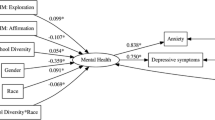Abstract
Ethnic and racial minority adolescents enter therapy with the behavioral, emotional, social, familial, and educational problems common to clinical practice. However, therapy with these youth necessitates attention to the effects of racial discrimination on their psychological functioning and to matters of how their ethnic or racial identities are integrated. Of the myriad issues that become part of therapy with minority adolescents, the profound effects of racism and the process of ethnoracial identity development can be seen in adolescents' sense of self and behavior. Experiences with racism and with their own ethnic reference group and others may have led to distortions and partial understanding of their identities that may affect adaptation and functioning. In this paper, the author draws from experiences in clinical practice with minority youth to highlight issues of racism and ethnic identity emergent in treatment. Three cases illustrate discussions of struggles with racism and ethnic identity as they emerged in therapy. In each case, the struggles were made salient by the therapist's purposeful eliciting of them to clarify issues of transference, family relations, peer group relations, and achievement.
Similar content being viewed by others
REFERENCES
Clark, R., Anderson, N. B., Clark, V. R., & Williams, D. R. (1999). Racism as a stressor for African Americans: A biopsychosocial model. American Psychologist, 54, 805–816.
Comas-Diaz, L., & Jacobsen, F. M. (1987). Ethnocultural identification in psychotherapy. Psychiatry, 50, 232–241.
Comas-Diaz, L., & Jacobsen, F. M. (1991). Ethnocultural transference and countertransference in the therapeutic dyad. American Journal of Orthopsychiatry, 61, 392–402.
Cornell, D. G., Peterson, C. S., & Richards, H. (1999). Anger as a predictor of aggression in incarcerated adolescents. Journal of Consulting and Clinical Psychology, 67, 108–115.
Dyche, L., & Zayas, L. H. (1995). The value of curiosity and naivete for the cross-cultural psychotherapist. Family Process, 34, 389–399.
Erikson, E. H. (1950). Childhood and society. New York: Norton.
Erikson, E. H. (1968). Identity: Youth and crisis. New York: Norton.
Fordham, S., & Ogbu, J. U. (1986). Black students' school success: Coping with the “burden of acting White. ” Urban Review, 18, 176–206.
Grier, W. H., & Cobbs, P. M. (1968). Black rage. New York: Basic Books.
Jackson, J. S., Brown, T. N., Williams, D. R., Torres, M., Sellers, S. L., & Brown, K. (1996). Racism and the physical and mental health status of African-Americans: A 13-year national panel study. Ethnicity and Disease, 6, 132–147.
Klonoff, E. A., Landrine, H., & Ullman, J. B. (1999). Racial discrimination and psychiatric symptoms among Blacks. Cultural Diversity and Ethnic Minority Psychology, 5, 329–339.
Newhill, C. (1990). The role of culture in the development of paranoid symptomatology. American Journal of Orthopsychiatry, 60, 176–185.
Author information
Authors and Affiliations
Rights and permissions
About this article
Cite this article
Zayas, L.H. Incorporating Struggles with Racism and Ethnic Identity in Therapy with Adolescents. Clinical Social Work Journal 29, 361–373 (2001). https://doi.org/10.1023/A:1012267230300
Issue Date:
DOI: https://doi.org/10.1023/A:1012267230300



